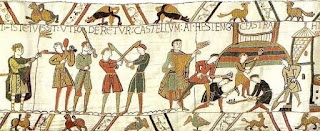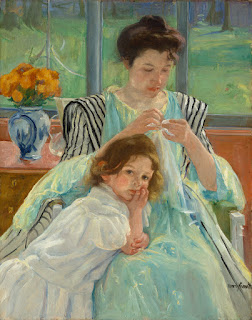Post #2
10/16/17
Gender Roles, Subject, and Power
Referring to a discussion in class in which the roles women and men held were analyzed during the Middle Ages, Renaissance and so on, it is to be noted that men were part of the "public space", which was to make money for the household by working, owning land and were able to go to school. Meanwhile, women were expected to be in the "private space", which meant taking care of the kids, cooking, and cleaning. If you were a nun during the Middle Ages (in which the printing press was established), then luckily you were able to read. Women weren't allowed to do the things men were able to because of their gender. To go to school and become educated if you were a woman was frowned upon because then it meant women would stop being inferior and could rise above men. Overall, women were valued for their body and sexuality, meanwhile, men were valued for the physical appearance and intelligence. John Berger in "Ways of Seeing" states that "she has to survey everything she is and everything she does because how she appears to others, and ultimately how she appears to men, is of crucial importance for what is normally thought of as the success of her life. Her own sense of being in herself is supplanted by a sense of being appreciated as herself by another" (Berger 46). Women are scrutinized by men and have to act as objects for their satisfaction, as stated in the quote. A quote from the Beside Companion to the History of Western Art by the Guerilla Girls taken from the New Testament says, "Let the woman learn in silence with all subjection. But suffer not a woman to teach, nor to usurp authority over the man. But to be in silence"(Guerilla Girls 19). In Chadwick's Book "Women, Art, and Society", St. Paul's teaching states that "a woman must be a learner, listening quietly and due submission. I do not permit a woman to be a teacher, nor must a woman domineer over a man; she should be quiet" (Chadwick 45). Women were to be passive, but not active in a male-dominated society.
Many of the religious objects, manuscripts, and tapestries were made by women artists who were nuns or working under men, but they are rarely noted since they didn't sign. As mentioned beforehand, "women were to look over large estates while men were at war or occupied elsewhere on business" (Chadwick 47). An important monument during this time to take note of would be the Bayeux Tapestry (pictured below),
 |
| Bayeux Tapestry, 1066 |
 |
| Herrad of Landsberg, Hortus Deliciarum, 11th century |
Chadwick's book says that "women made no contribution to the scholastic philosophy and dominant theology...". They were also "excluded from the intellectual life of cathedral schools and universities in which students were legally clerics, a rank not open to women" (Chadwick 58). To further this point, Guerilla Girls states that "Education was thought to interfere with a woman's ability to be a good wife and mother. Almost no women were taught to read and write" (Guerilla Girls 22). In summation, women mostly worked for family businesses ran by men and nuns were able to read, and lived a dedicated life to God in Church, in which books like Scivas by Hildegard Von Bingen were written.
When one thinks about the Renaissance, the term 'Renaissance Man' comes to mind, which is often associated with Michelangelo, Leonardo, and other artists during this time. Guilds that taught artist skills were closed to women. Women artists came to be because of their parents, who taught them, and so artists like Sofonisba Anguissola and Lavinia Fontana worked with their fathers in order to become known. In Bologna, women were allowed to be educated and there was even a school for women artists. Like in the Middle Ages, women were still limited from achieving their full potential. The "Public space" was "associated with the arts of painting, sculpture, and architecture,"(Chadwick 74) which pertained to men. These women artists, like Anguissola, started doing their own version of self-portraits (pictured below), which contrasted with the male counterpart.
 |
| Sofonisba Anguissola, Self Portrait at the Easel, 1556 |
It included: femininity, wealth and lineage and basically portrayed them as objects. Social status among women was crucial as well, as seen with Anguissola who was prohibited from selling work. Chadwick book also states that "Anguissola could not use paint as a metaphor for possessible beauty without violating the social role that made possible her life as a painter" (Chadwick 84). Elisabetta Sirani's Portia Wounding Her Thigh pictured below portrays strength by Portia stabbing herself in the thigh. "Portia has to prove herself virtuous and worthy of political trust by separating herself from the rest of her sex" (Chadwick 101).
 |
| Elisabetta Sirani, Portia Wounding Her Thigh, 1664 |
Sirani's and Gentileschi's piece Judith Decapitating Holofernes is setting them apart from the gender roles that have been implied to them ever since. The depiction of courage and power is strongly showcased. Gentileschi's Judith with Her Maidservant goes against the male gaze, and instead, there is a "direct confrontation which disrupts the conventional relationship between an "active" male spectator and a passive female recipient." During the Renaissance, these brave women artists started going against what was expected of them and instead showed a side that many didn't like, but was important and motivating.
Moving on the 19th Century, Women rights were still as limited but their labor was essential in building Colonial America. In Europe, it was even tougher. Women also gained the right to vote in 1848 following the Women's Rights Convention, and many believe that feminist movement began from here. The views of femininity were still put upon these women artists. Even so, opportunities for women started increasing but in exchange, they had to take on the role of housewife. In Women, Art, and Society, it says that "Geography and class played a significant role in shaping the experiences of nineteenth-century American women artists" (Chadwick 211). Needlework and sculpting also became prevalent and it includes artists like Harriet Powers, who was born a slave and is known for her Pictorial Quilt. Harriet Powers and Harriet Hosmer focused on abolitionist themes, along with Edmonia Lewis. Rosa Bonheur focused on horses, cows, and bulls; and if there were men in the scene, as seen in her painting The Horse Fair, they're not important. She even crossed dressed with her partner in order to travel. In Guerilla Girls, it states that "Rosa, like Mary Cassatt, was involved in the early women's movement" (Guerilla Girls 49). Photography also came into bloom and so artists like Julia Margaret Cameron photographed refined women and renowned old men. With this came Impressionism, and artists like Mary Cassatt and Berthe Morisot incorporated women into their works, but without the prominent male gaze. They both depicted women at work, not as the sexual objects they were portrayed as usually.
 |
| Mary Cassatt, Young Mother Sewing, 1900 |
 |
| Berthe Morisot, The Mother and Sister of the Artist, 1869 |
To be a woman artist was extremely difficult when most painters and intellects were men. Women's paintings were ridiculed, or because they were "feminine," they were instantly not good. In order to become known, women artists had to work twice as hard and even so, most of their works are lost to this today. It's not to say that female artists are seen as equal as male artists now because there still is misrepresentation; but hopefully, with time, things will start to look better.
Works Cited:
Chadwick, Whitney. Women, Art and Society. Thames and Hudson, 2015.
The Guerrilla Girls' Bedside Companion to the History of Western Art. Penguin Books, 2006.
“A Brief History of Women in Art.” Khan Academy, www.khanacademy.org/humanities/art-history-basics/tools-understanding-art/a/a-brief-history-of-women-in-art.Gender Roles of Women in the Renaissance, www2.cedarcrest.edu/academic/eng/lfletcher/shrew/acloud.htm.
No comments:
Post a Comment
Note: Only a member of this blog may post a comment.